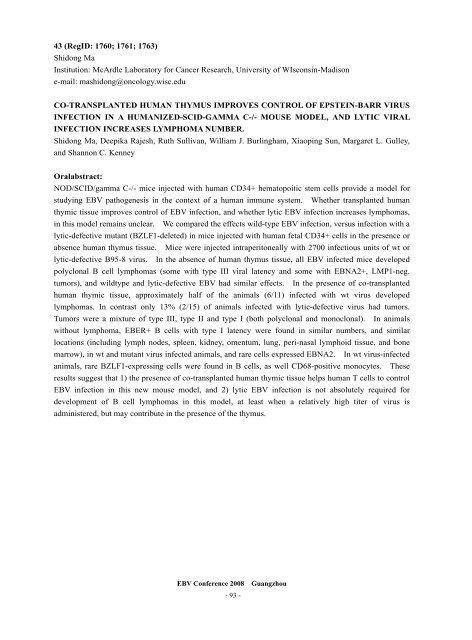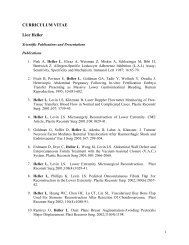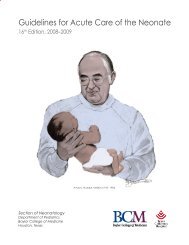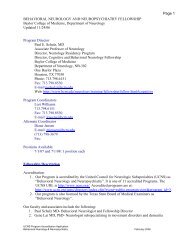EBV Conference 2008 Guangzhou - Baylor College of Medicine
EBV Conference 2008 Guangzhou - Baylor College of Medicine
EBV Conference 2008 Guangzhou - Baylor College of Medicine
You also want an ePaper? Increase the reach of your titles
YUMPU automatically turns print PDFs into web optimized ePapers that Google loves.
43 (RegID: 1760; 1761; 1763)<br />
Shidong Ma<br />
Institution: McArdle Laboratory for Cancer Research, University <strong>of</strong> WIsconsin-Madison<br />
e-mail: mashidong@oncology.wisc.edu<br />
CO-TRANSPLANTED HUMAN THYMUS IMPROVES CONTROL OF EPSTEIN-BARR VIRUS<br />
INFECTION IN A HUMANIZED-SCID-GAMMA C-/- MOUSE MODEL, AND LYTIC VIRAL<br />
INFECTION INCREASES LYMPHOMA NUMBER.<br />
Shidong Ma, Deepika Rajesh, Ruth Sullivan, William J. Burlingham, Xiaoping Sun, Margaret L. Gulley,<br />
and Shannon C. Kenney<br />
Oralabstract:<br />
NOD/SCID/gamma C-/- mice injected with human CD34+ hematopoitic stem cells provide a model for<br />
studying <strong>EBV</strong> pathogenesis in the context <strong>of</strong> a human immune system. Whether transplanted human<br />
thymic tissue improves control <strong>of</strong> <strong>EBV</strong> infection, and whether lytic <strong>EBV</strong> infection increases lymphomas,<br />
in this model remains unclear. We compared the effects wild-type <strong>EBV</strong> infection, versus infection with a<br />
lytic-defective mutant (BZLF1-deleted) in mice injected with human fetal CD34+ cells in the presence or<br />
absence human thymus tissue. Mice were injected intraperitoneally with 2700 infectious units <strong>of</strong> wt or<br />
lytic-defective B95-8 virus. In the absence <strong>of</strong> human thymus tissue, all <strong>EBV</strong> infected mice developed<br />
polyclonal B cell lymphomas (some with type III viral latency and some with EBNA2+, LMP1-neg.<br />
tumors), and wildtype and lytic-defective <strong>EBV</strong> had similar effects. In the presence <strong>of</strong> co-transplanted<br />
human thymic tissue, approximately half <strong>of</strong> the animals (6/11) infected with wt virus developed<br />
lymphomas. In contrast only 13% (2/15) <strong>of</strong> animals infected with lytic-defective virus had tumors.<br />
Tumors were a mixture <strong>of</strong> type III, type II and type I (both polyclonal and monoclonal). In animals<br />
without lymphoma, EBER+ B cells with type I latency were found in similar numbers, and similar<br />
locations (including lymph nodes, spleen, kidney, omentum, lung, peri-nasal lymphoid tissue, and bone<br />
marrow), in wt and mutant virus infected animals, and rare cells expressed EBNA2. In wt virus-infected<br />
animals, rare BZLF1-expressing cells were found in B cells, as well CD68-positive monocytes. These<br />
results suggest that 1) the presence <strong>of</strong> co-transplanted human thymic tissue helps human T cells to control<br />
<strong>EBV</strong> infection in this new mouse model, and 2) lytic <strong>EBV</strong> infection is not absolutely required for<br />
development <strong>of</strong> B cell lymphomas in this model, at least when a relatively high titer <strong>of</strong> virus is<br />
administered, but may contribute in the presence <strong>of</strong> the thymus.<br />
<strong>EBV</strong> <strong>Conference</strong> <strong>2008</strong> <strong>Guangzhou</strong><br />
- 93 -







